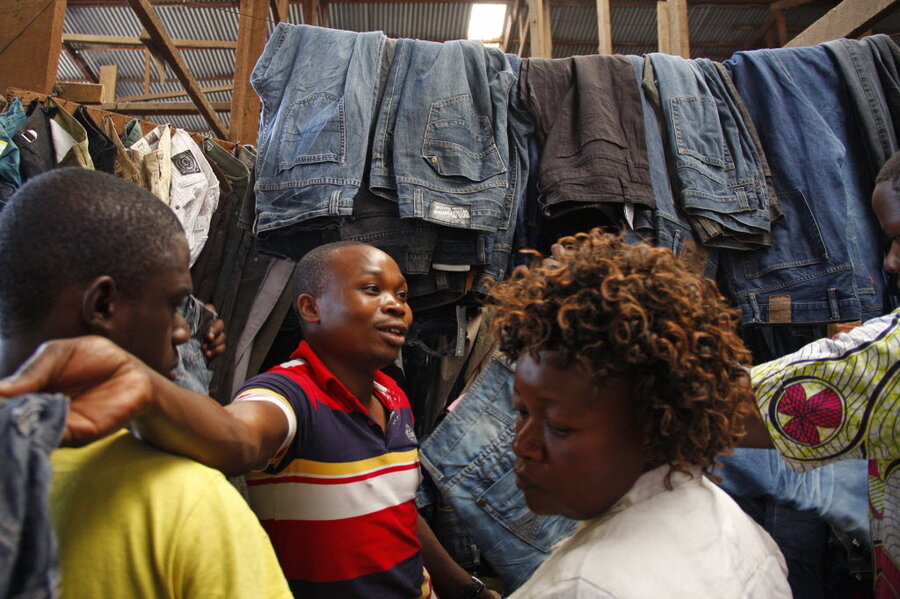In secondhand designer duds, Eastern Congo locals are defiantly dapper
Loading...
| Goma, Democratic Republic of Congo
Diesel jeans for $10. Converse hi-tops for $8 a pair. iPads for $250.
Status-conscious but cash-strapped Goma hosts a robust trade in everything secondhand. My first days there, I gawked at the parade of designer and brand names – Versace, Chanel, Gucci, Ray Ban, Adidas, Lacoste – crossing my path on the roads of broken-up volcanic rock and dirt.
Out on a Saturday night, my Gap jeans and no-name T-shirt felt provincial among the well-tailored blazers – with silk handkerchiefs in the chest pockets – and towering stilettos, the designer labels often stealthily visible. To pay for a round of drinks my fixer pulled out dollars – as much a local currency as the Congolese franc – from the Gucci waist belt he often wore.
Within Africa, the two Congos – Kinshasa and Brazzaville – are known for their exquisite fashion sense and their love for brands. And although Kinshasa is king when it comes to vintage designer finds, Goma is no slouch. This city of 1.3 million, overrun by rebels two years ago and thousands of miles from a port or manufacturing point, has no shopping mall or big box store. But it’s secondhand markets make it easy to look good.
This is the country of sapeurs – dandies who don sharp get-ups daily despite the poverty, oppression, and conflict often surrounding them. Being a member of the so-called Société des Ambianceurs et des Personnes Élegantes (SAPE), will earn you a combination of rolled eyes and a yelp of glee. The organization uses dressing well as an act of defiance against difficult circumstances – in Eastern Congo that would be the cycle of violence and never-ending dependence on humanitarian aid for basic needs.
Yet tease a well-dressed man in Goma by calling him a sapeur, and he’ll act horrified – but be pleased he looks sharp enough to earn the name.
Everyone from fashion-conscious 20-somethings to mothers of three can be found pawing through mounds of clothing at the single-item stalls of Virunga Market, Goma’s largest secondhand market. Dealers bring in thousands of kilograms of used clothing every month, transported from the ports at Mombasa and Dar es Salaam, piling it high in warehouses where shop owners buy it by the 45-kilogram package.
The size of the secondhand economy demands order and hierarchy. In this manufacturing-deficient country, customs revenue makes up 45 percent of Congo’s national budget, and the government is intent on making sure the secondhand items don’t escape taxation. And although they seem completely informal, the various markets have associations, rules for joining, and leadership that make decisions and try to prevent stolen goods from entering the market.
Used socks, too
At Virunga market, you will find a maze of stalls selling everything from the infamously ubiquitous T-shirts left over from sororities’ charity 5ks to Steve Madden high heels. And on every street, you’ll find a hawker selling a couple dozen pants, shirts, and jackets hanging from a nearby corrugated metal wall.
Even Goma residents with disposable income say they prefer used pants with a good name over the new, no-name options or knockoffs. “It’s only politicians and NGOs who use brand new stuff,” says George, an adviser to North Kivu Province’s economic minister who declined to give his last name. He estimates that 70 to 80 percent of the population – himself included – wear mostly secondhand items. This wealthy government official wiggles his feet and lifts up his pants leg, pointing to his socks. Used.
“One thing is for sure, secondhand clothes is a top business. It’s always moving quickly,” he says. “In a few days or a week, [a dealer] will tell you he finished already” selling his most recent import of used clothes. New clothes don’t move nearly as quickly.
Nyangi Mulonda Innocent, the head of one of the secondhand clothing cooperatives in Goma and a jeans seller, says his most popular brands are Versace, Calvin Klein, and Levi's. They all sell for $10 a pop.
“Everywhere in the world, people like labels, people like brands,” he says, adding that the Chinese knock-offs fall apart, the colors running on first wash.
Secondhand, but uniquely you
And they also pride themselves on originality. If you buy a T-shirt in one of Goma’s few formal stores (patronized mostly by United Nations peacekeepers, high-up politicians, and international NGO workers, according to the owner of a store called Gucci Fashion), you risk running into someone wearing the same thing, says Dunat Iseso, one of Goma’s seven traders of used clothes.
“Here in secondhand [stores], if you’re lucky you get a nice shirt and it will be just for you,” he says, leaning on one of the shrink-wrapped bundles of clothing bearing labels like “swim trunks” or “jogging pants.” Sometimes you also find brand-new items packed in with the rest, he marvels.
Sandra Ngalula, who buys bundles from Mr. Iseso and sells them out of her home to neighborhood women, assents.
“Secondhand you get something that belongs only to you,” she says.
When asked if you can dress well relying only on secondhand clothes, she gestures to her dark skinny jeans, tank top, denim button-down, and strappy sandals. All secondhand.
“Just imagine when I’m smart!” she says.
This story was reported with support from the International Women's Media Foundation (IWMF).






